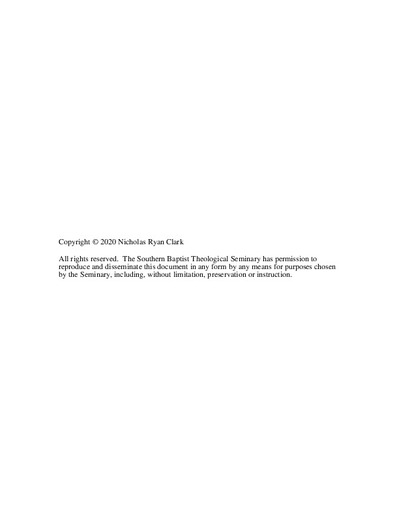| dc.contributor.advisor | Beougher, Timothy K. | |
| dc.contributor.author | Clark, Nicholas R. | |
| dc.date.accessioned | 2020-12-03T14:50:24Z | |
| dc.date.available | 2020-12-03T14:50:24Z | |
| dc.date.issued | 2020-11-12 | |
| dc.identifier.uri | https://hdl.handle.net/10392/6401 | |
| dc.description.abstract | This dissertation examines the theology and practice of evangelism of Lewis A. Drummond to show that effective evangelism does not happen apart from a commitment to biblical inerrancy. Chapter 1 introduces the thesis by examining the utility of a theology of evangelism. The principal argument of this dissertation shows that Drummond’s integration of epistemology and kerygma shape a theology of evangelism rooted in biblical inerrancy which is the basis for an effective evangelistic ministry.Chapter 2 provides a biographical sketch of Lewis A. Drummond that details the events of his early life including his conversion and service in World War II. This section also outlines the contributions of his academic training and pastoral ministry before entering the teaching ministry of a professor and his eventual presidency of SEBTS.
Chapter 3 presents Drummond’s epistemological work for the building of an authority for evangelism. His academic work in philosophy and influence of Charles Arthur Campbell and Rudolf Otto help feed Drummond’s defense of the supra-rational character of God as part of the authority for evangelism. The chapter culminates in the usefulness of propositional revelation in evangelism and apologetics. Drummond’s doctrine of Scripture gives the final shape to the authority for evangelism.
Chapter 4 includes the heart of a theology of evangelism that is shaped by the kerygma. The two aspects of the kerygma Drummond argued included the cognitive and experiential. Both elements are essential to gospel heralding and this chapter will explore the particulars of the cognitive elements including the doctrines of salvation and the Trinity.
Chapter 5 explains the experiential aspect of the kerygma in terms of the efforts made to bring spiritual renewal. This section also delves into the synthesis of the kerygmatic structure for a theology of evangelism by assessing Drummond’s commitment to the sovereignty of God in revival (cognitive) as well as the doctrine of the church (experiential). The chapter ends with Drummond’s implications for church health beginning in revival.
Chapter 6 assesses Drummond’s evangelistic practice in theological education and evangelicalism in a broader sense. This chapter helps provide the context of Drummond’s educational ministry which makes his commitment to kerygmatic proclamation stand in bold relief. This chapter also looks at Drummond’s widening impact on evangelicals worldwide in the Billy Graham Evangelistic Association, Baptist World Alliance, and his later writings.
Chapter 7 gives a summary of the analysis and its implications for the field of evangelism. The chapter points out additional avenues for further research in the life and ministry of Drummond and final reflections. | en_US |
| dc.subject.lcsh | Evangelistic work | en-us |
| dc.subject.lcsh | Kerygma | en-us |
| dc.subject.lcsh | Drummond, Lewis A. | en-us |
| dc.title | The Theology of Evangelism in the Ministry of Lewis Addison Drummond | en_US |
| dc.type | Electronic dissertation | en_US |
| dc.type | Text | |
| dc.contributor.committee | Greenway, Adam W. | |
| dc.contributor.committee | Wills, Gregory A. | |
| dc.type.qualificationname | Ph.D. | en_US |
| dc.publisher.institution | Southern Baptist Theological Seminary | en_US |
| dc.publisher.department | School of Missions and Evangelism | |

